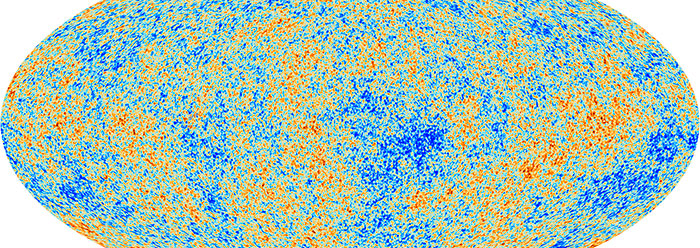On March 17, a team of radio astronomers announced they discovered purportedly direct evidence for cosmic inflation—a critical component of the modern Big Bang model. To make this discovery, the researchers used a specialized telescope called BICEP2 located on the Antarctic plateau.1
Radiation that has its strongest intensity in the microwave portion of the electromagnetic spectrum comes to us from all directions in space. Secular researchers interpret this cosmic microwave background radiation (CMB) as "relic radiation" from a time about 400,000 years after the alleged cosmic explosion. Now, a team of astronomers led by John M. Kovac of the Harvard-Smithsonian Center for Astrophysics claims to have found faint, swirly patterns, called "B-mode polarization," that are thought to have been imprinted on the CMB by primordial "gravity waves" as a result of the inflationary process.
The original Big Bang model had a number of serious and even fatal difficulties, including its own version of the "starlight and time" problem known as the horizon problem.2 In an attempt to solve these issues, secular scientists proposed an ad hoc "tack-on" to the model called inflation. Inflation was originally said to be an extremely rapid but brief growth spurt of the universe that occurred shortly after the supposed Big Bang, although secular cosmologists now tend to view it as the cause of the Big Bang itself.3
Do the BICEP2 data really show undeniable evidence for cosmic inflation, and by implication, the Big Bang? Not at all.
First, these results have not yet been confirmed, and even secular cosmologists are cautioning that these signals could be caused by factors other than inflation, although they believe this is unlikely.1
Second, although secular scientists are very excited by this discovery, they were nevertheless "surprised" by it.1 Gravitational waves are thought to have caused these swirly polarization patterns. The relative size of these waves is characterized by a parameter called the tensor-to-scalar ratio and indicated by the symbol r. A previous team of scientists who analyzed the Planck satellite data concluded that there was only a five percent probability that r could be greater than 0.11.4 Yet the BICEP2 team is reporting that r is most likely about 0.20. Since their reported error bars allow for some wiggle room, these results do not necessarily contradict one another, but there is a bit of a tension between them, as acknowledged by the BICEP2 team.5
In this light, a statement by physicist Marc Kamionkowski is extremely interesting: "Although I might not fully understand it,…this is a signal from the very earliest universe, sending a telegram encoded in gravitational waves."6 The fact that a physicist may not "fully understand" the implications of these data might not normally be all that significant, except for the fact that Kamionkowski is one of the scientists who first predicted that inflation should have resulted in B-mode polarization in the CMB!7 If he doesn't fully understand the implications of the data, then why should anyone accept the claims that these data somehow prove inflation? Interestingly enough, the candid admission in the first part of Kamionkowski's statement was quickly removed from the online New York Times article in which it originally appeared, although it did appear in other news outlets.1,6,8
Finally, other aspects of the CMB data are very problematic for the Big Bang model, despite the positive spin that secular scientists have put on them. One of the fundamental assumptions of the Big Bang model is isotropy, the idea that, on the largest scales, there are no special directions in space. If this assumption is correct, then the CMB should appear essentially the same in all directions. Yet the presence of an "axis of evil" and a cold spot in the CMB data undermine this assumption, as well as the inflation hypothesis itself.
Originally, secular theorists thought they could dismiss these anomalies as the result of poor-quality data. The newer Planck results, however, do not leave them this convenient option.9,10 Just last year, Phys.org reported Cambridge astrophysicist and member of the Planck team George Efstathiou as saying, "[T]he theory of inflation predicts that today's universe should appear uniform at the largest scales in all directions" and that the "uniformity should also characterize the distribution of fluctuations at the largest scales within the CMB. But these anomalies, which Planck confirmed, such as the cold spot, suggest that this isn't the case."11 Finally, he went on to say, "[T]his is very strange....And I think that if there really is anything to this, you have to question how that fits in with inflation....It's really puzzling."11 So, we are now being told that the CMB radiation proves inflation, even though we were informed just last year that it is also apparently inconsistent with inflation.
So what did cause the CMB? That's an open question. But since the CMB data are generally inconsistent with inflation (a fact quickly glossed over in Monday's announcement), it is definitely not "leftover" radiation from an alleged Big Bang. Secular scientists have made many such splashy announcements over the years, announcements which have supposedly proven various aspects of their evolutionary worldview but which have eventually been rejected (often quietly) by evolutionists themselves. This is not the first such announcement, nor will it be the last. Readers should resist the temptation to embrace these ever-changing secular origin stories. The inerrant, inspired, true creation account never changes, however: "The grass withers, the flower fades, but the word of our God stands forever" (Isaiah 40:8).
References
- Overbye, D. Space Ripples Reveal Big Bang's Smoking Gun. New York Times. Posted on nytimes.com March 17, 2014, accessed March 17, 2014.
- Lisle, J. 2003. Light-travel time: a problem for the big bang. Creation. 25 (4):48-49.
- Guth, A. The Inflationary Universe: Alan Guth. Edge. Posted on edge.org November 19, 2002, accessed March 17, 2014.
- Ade, P. A. R. et al. 2013. Planck 2013 results: XXII. Constraints on inflation. Astronomy & Astrophysics. Posted on arxiv.org December 6, 2013, accessed March 17, 2014.
- Ade, P. A. R. et al. 2014. BICEP2 I: Detection of B-mode Polarization at Degree Angular Scales. To be submitted to a journal TBD. Posted on arxiv.org March 17, 2014, accessed March 17, 2014.
- Overbye, D. Space ripples seen as Big Bang's smoking gun. Reposted by the Houston Chronicle. Posted on houstonchronicle.com March 17, 2014, accessed March 17, 2014.
- Moskowitz, C. Gravitational Waves from Big Bang Detected. Scientific American. Posted on scientificamerican.com March 17, 2014, accessed March 17, 2014.
- Overbye, D. Space waves seen as further proof that universe was born in Big Bang. Reposted by the Anchorage Daily News. Posted on adn.com March 17, 2014, accessed March 17, 2014.
- Aron, J. 2013. Planck shows almost perfect cosmos – plus axis of evil. New Scientist. Posted on newscientist.com March 21, 2013, accessed March 17, 2014.
- Hebert, J. 2013. The Planck Data and the Big Bang. Creation Science Update. Posted on icr.org April 3, 2013, accessed March 17, 2014.
- 2013. Discoveries from Planck may mean rethinking how the universe began. Phys.org. Posted on phys.org July 26, 2013, accessed March 17, 2014.
Image credit: Copyright © 2014 ESA (European Space Agency). Adapted for use in accordance with federal copyright (fair use doctrine) law. Usage by ICR does not imply endorsement of copyright holders.
* Dr. Hebert is Research Associate at the Institute for Creation Research and received his Ph.D. in physics from the University of Texas at Dallas.
Article posted on March 21, 2014.

















